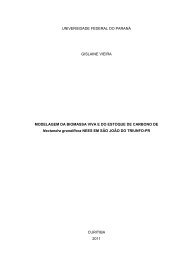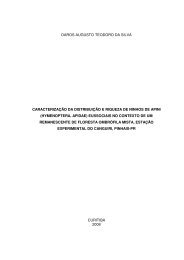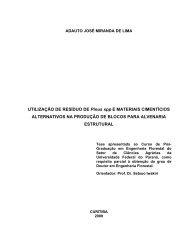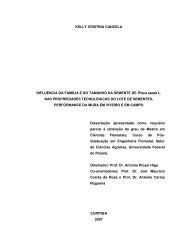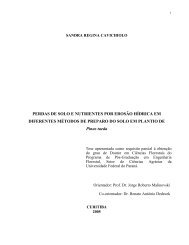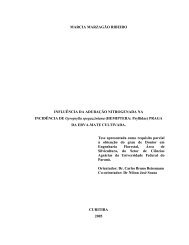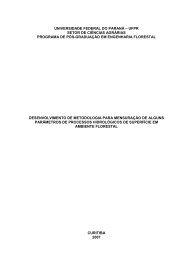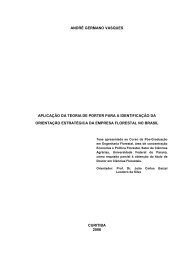Tese em PDF - departamento de engenharia florestal - ufpr ...
Tese em PDF - departamento de engenharia florestal - ufpr ...
Tese em PDF - departamento de engenharia florestal - ufpr ...
Create successful ePaper yourself
Turn your PDF publications into a flip-book with our unique Google optimized e-Paper software.
ABSTRACT<br />
(Ecological wood anatomy of 19 native tree species of Paraná state, Brazil) In or<strong>de</strong>r<br />
to investigate the ecological relationships between the anatomical el<strong>em</strong>ents of the<br />
secondary xyl<strong>em</strong> and environment, in this study was evaluated the wood of native<br />
tree species from the Paraná state, consi<strong>de</strong>ring the environmental peculiarities in<br />
which they occur. Were sampled 19 species, of 14 families, in <strong>de</strong>nse and mixed rain<br />
forests. Some species have great ecological plasticity (generalists), while others are<br />
specialists in relatively narrow niches, such as those that occur predominantly in<br />
waterlogged soils (hydrophilous), high-montane environments and/or coastal plain.<br />
For intraspecific analysis were sampled 16 trees of Calophyllum brasiliense, 11 of<br />
Tapirira guianensis, from two soil: Organosol (O) and Spodosol (E) and 13<br />
individuals of Ilex theezans in Spodosols (non-hydromorphic and hydromorphic) in<br />
the coastal plain of Paraná state. Were also sampled 21 trees of Sebastiania<br />
commersoniana in three soil units (Psamitic Sediment, Melanic Gleysol and Fluvic<br />
Neosol) in the Iguaçu river plain. The wood samples were collected with a Pressler<br />
incr<strong>em</strong>ent borer with 12 mm diameter, 1.30 m above the ground. Histological sli<strong>de</strong>s<br />
were prepared with 18-22 mm thick sections and dissociated material. We analyzed<br />
the vessel diameter (DV), vessel frequency (FV), vessel grouping (AV), the<br />
percentage of area occupied by the xyl<strong>em</strong> vessels (% AV), the vessel el<strong>em</strong>ents<br />
length (CEV), the fiber length (CF), the fiber width (LF), the fiber wall thickness (EPF)<br />
and the height (AR) and width of the rays (LR). Were calculated the vulnerability (VN)<br />
and mesomorphic (MS) in<strong>de</strong>x. The data were subjected to principal component<br />
analysis (ACP) and cluster analysis. To compare the averages we used the Duncan<br />
test and "t" test. Most of studied species have diffuse porosity, with distinct growth<br />
layers, especially marked by radial flattening of the fiber walls and walls thickening. In<br />
some species it was observed a ten<strong>de</strong>ncy for s<strong>em</strong>icircular porosity formation, with<br />
variations in diameter and frequency of vessels in earlywood and/or latewood.<br />
Consi<strong>de</strong>ring the principal component analysis, 72% of the variation in the data is<br />
explained by the first three axes. The variation in fiber (CF, LF, EPF) and vessels<br />
(FV, DV) characteristics tend to be orthogonal in the first two axes of the ACP.<br />
Therefore, in functional terms, it can be assumed that the first axis is related to<br />
biomechanical factors of the secondary xyl<strong>em</strong>, and the second and third axis are<br />
more directly related to hydraulic conductance. In cluster analysis, were formed two<br />
main groups: the first with the species that occur mainly in non-hydromorphic soils of<br />
the Lowland Dense Rain Forest and High-Montane Dense Rain Forest; the second<br />
group with the species of hydromorphic soils of the Fluvio-lacustrine Pioneer<br />
Formation and Alluvial Mixed Rain Forest. In the intra-specific analysis were<br />
i<strong>de</strong>ntified different patterns of anatomical variation of the studied species. The results<br />
are discussed based on the literature, consi<strong>de</strong>ring the characteristics of the study<br />
sites and auto-ecology of the species.<br />
Key words: ecological anatomy, forest ecology, functional morphology, secondary<br />
xyl<strong>em</strong>.<br />
vii




